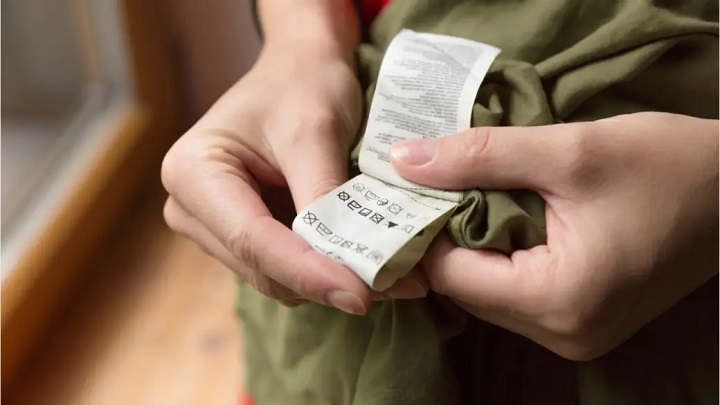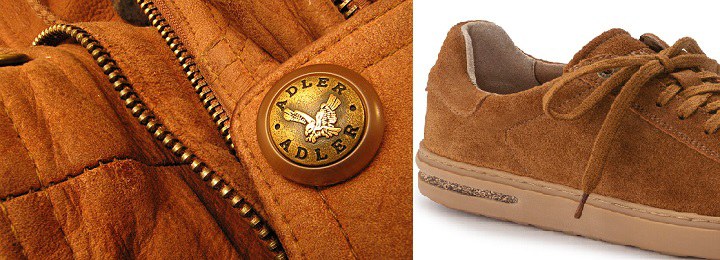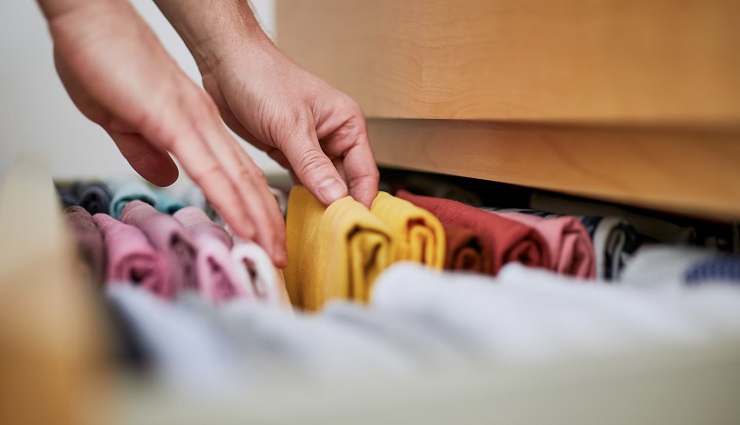Proper washing of clothes is essential for durability and maintaining their quality. Many clothes do not require special care, but some clothes and accessories cannot be washed at home by hand or in a washing machine. These clothes are usually delicate and vulnerable, and contact with water and detergents and strong shaking of the washing machine will damage them. In the following, we will learn more about how to dry-clean clothes and the types of clothes and fabrics that need dry-cleaning.
What is dry cleaning?
Dry cleaning means clothes and other textile items are cleaned without water. In this process, clothes and accessories are immersed in a liquid cleaning solvent, and cleaning solutions are used instead of water. That’s why we call this method dry cleaning.
Perchloroethylene is a standard cleaning solution in dry cleaning. However, some dry cleaners have switched to more environmentally friendly products, such as liquid carbon dioxide, silicone-based solvents, and DF-2000 hydrocarbon solvents.
Dry cleaning is recommended to prevent delicate fabrics from drying out. Materials are usually stretched during the garment production process. When you wash clothes many times in the washing machine, you will notice that they have become a size smaller. Other benefits of dry cleaning include:
- protection of clothing color;
- maintaining the shine and texture and original form of the clothes;
- more effective removal of oil and grease stains;
- Better preservation of silk, wool, and other natural fibers.
What clothes should only be dry cleaned?

The easiest way is to pay attention to the clothing label and its signs. Most manufacturers are required to specify only one method for cleaning clothing. If the garment should be dry-cleaned only according to the title, avoid regular washing with water. But if the recommended method is “dry cleaning” on the label, it means it is better but not required. When dealing with clothes that are better but not required to be dry-cleaned, you can use gentle techniques to wash them at home.
We use the following methods to wash and dry delicate clothes at home:
- If the garment is durable and does not stain, soak it in the washing machine. Use the washing machine’s gentlest setting to reduce the device’s vigorous shaking, turn the clothes inside out, put them in a mesh bag, and run the short and delicate program.
- Hand wash delicate clothes. You can use gentle hand wash if it is better to dry clean the garment according to the label. Use cold water and mild detergent to prevent the clothes from drying out.
- Do not use a dryer, as high heat will damage the fabric and fibers of the clothes. Gently squeeze excess water from the garment (don’t wring it), then lay it flat on a white towel to dry to prevent discoloration. You can also air dry the clothes.
Ten determining factors for using dry cleaning
It is indicated on the clothes label that we should wash the clothes with a washing machine or by hand or dry clean them. But if the label is unclear or worn or your clothes don’t have a brand, you can pay attention to the 10 points below.
1. Ease of ironing clothes

A pleated skirt or shirt with stripes is more challenging to iron than plain T-shirts. Such clothes should not be washed at home; regular washing will make the pleats and stripes messy. Ironing such clothes is also tricky. You may be unable to return them to their original beauty and order.
2. Inner lining
If the garment has an internal lining, you should check whether the lining fabric is washable. For example, acetate and polyester fabrics do not wash with normal water. While cotton, viscose, and rayon linings may get watery and shrink when washing clothes. Silk or woolen linings require special care when cleaning.
3. The presence of leather pants
Sometimes clothes are decorated with leather pieces or used in other ways. For example, leather pieces may be used in the elbow area of a denim jacket. If you wash these clothes, the leather part will be damaged. Leather is a natural material. The oil in the leather binds to the water molecules, so after regular washing, the water dries out and removes the crude oil in the leather. As a result, the leather becomes hard and brittle, and the clothes lose their original charm.
4. Dyeing clothes
If a garment stains, you should not wash it at home. To check the color stability of the clothes, you can moisten some cotton with a mild detergent and drag it on the hem or inner seam of the clothes. If the color is transferred to the cotton, you should not wash the garment at home, as it will cause the garment’s original color to disappear. Special chemicals are used in dry cleaning to preserve the fabric’s color.
5. clothing value
Accidents may happen while washing clothes, and clothes may get damaged. It doesn’t feel good to have clothes damaged in the wash, especially if it happens to an expensive and valuable garment. Dry cleaning minimizes the risk of damage to clothes. Take costly clothes such as expensive suits, wedding dresses, and evening dresses to the dry cleaners to preserve their appearance and shape better. Expensive and old clothes should be cleaned with more care. A reliable dry cleaner can clean them without damaging them.
6. Use of adhesive layer
Some jackets and coats have adhesive layers that give them a unique shape. The outer fabric may be washable, but the adhesive layer cannot withstand water or excessive shaking in the washing machine.
7. Sequin and bead embroidery
These clothes usually have loose seams, and the sequins and beads may come off after washing in the washing machine. If you want to wear your sequined and beaded garments for a long time, avoid washing them in the machine.
8. Embroidery and decorations
Some embroidery threads give color, and this causes the clothes to change color after washing with water. Metal decorations on clothes also lose their luster after cleansing in the washing machine. In addition, the creases and delicate ornaments of the garment are damaged by washing.
9. Clothing fibers
The clothes care label specifies the fibers used in it. Wash the clothes if you are sure that the fibers are washable. At home, you can usually wash cotton, linen, cashmere, polyester, acrylic, and nylon. But it would be best to take clothes made with silk, velvet, wool, and taffeta to the dry cleaners unless something else is written on the clothes label. Of course, some silk pajamas can also be washed in a washing machine.
You may not know much about fibers like spandex or acetate. Wash such fabrics when you have previously washed the clothes made from their fibers without any problems or if the clothes are washable according to the label.
In general, clothes made of some fibers cannot be washed. In the following, we have introduced these fibers.
1. leather
Natural leather should be dry cleaned because water damages it. Dry cleaning effectively removes oil, grease, and ink stains. Solvents used for dry cleaning can remove dirt and stains from leather clothes without damaging them. Therefore, it is better to dry-clean leather bags as well.
2. Suede leather

Suede leather is an expensive cow, goat, or lamb skin fabric. Like leather, suede is challenging to maintain because it is easily damaged by moisture, sunlight, and water-based cleaning products and chemicals. Improper washing can damage your suede pants, dress, gloves, and shoes.
3. silk
Silk is made of strong fibers that do not completely absorb the dyes used to dye the fabric. When you wash silk clothes with water and detergents, they lose their color and usually shrink over time. Dry cleaning silk clothes and accessories protect them from water damage and keep their colors vibrant and bright.
4. Raven
Rayon is a synthetic fabric with properties similar to silk, wool, cotton, or other materials. Therefore, it is common to use it in all kinds of clothes. Usually, the color used in rayon fabric comes out while washing it with hot water. As a result, the clothes become pale or change their color. Frequently washing raven clothes with hot water causes the clothes to become watery and lose shape.
Although hand-washing rayon clothing in cold water with a mild detergent is safe, dry cleaning is the best option to prevent discoloration and fading.
5. wool
This type of fabric usually fades when exposed to hot water, high heat, and mechanical solid shocks. Therefore, it is better not to use a washing machine to wash your woolen clothes. Water and washing devices are not used in dry cleaning, and the possibility of washing clothes is low. In addition, with this method, your woolen jacket’s buttons, beads, and other decorative elements will not loosen or fall off.
10. Longevity of clothes
If a garment has been in the closet for several years and has lost its original color and luster, it probably needs special care, and washing it at home may weaken the fabric. Because sometimes materials lose the ability to tolerate regular detergents, bleaches, and fabric softeners. You can use dry cleaning for such clothes.
you say
In addition to saving time, dry cleaning helps preserve clothes and other delicate and expensive items so you can use them longer. Have you ever washed clothes at home that needed dry cleaning? What other clothes do you think should be dry-cleaned? We will be happy if you share your experiences with us and your other friends.



